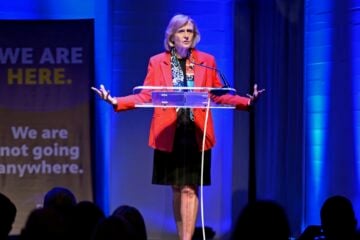NEA allotted this year’s media aid ‘to present art in new and . . . engaging ways’
Soon, listeners will hear celebrities read James Joyce’s entire masterpiece Ulysses via satellite and Internet radio; a New York City theater will use video-game technology to invent a new medium for the performing arts; and a San Francisco-based organization will craft computer data into interactive visual artworks.

Katrina, a young poet, presents her work in ITVS’s To Be Heard, which inspired a nonbroadcast project that NEA backed this year.
The projects are made possible through the newly expanded Arts in Media category from the National Endowment for the Arts, which this year branched out from primarily supporting public TV and radio programs. Last week the NEA announced 78 grants totaling $3.55 million, with an increased emphasis on technological innovation and multiplatform reach (Current, April 23).
Several of the largest grants, $100,000 each, went to high-profile first-time recipients with strong digital components. Open-source pioneer Mozilla Foundation of Mountain View, Calif. — parent of the Firefox browser — won for Open(Art), which will commission collaborations between artists and technologists to create and exhibit artwork on the Web. The Bay Area Video Coalition in San Francisco received a grant supporting the Factory Hybrid Filmmaking Project, a pilot for young filmmakers producing digital and web-native short films.
Innovation was paramount in the endowment’s choice of many of the grantees, a goal that it announced last year for the reconfigured category. “We’re excited about using media to present art in new and interesting and particularly engaging ways,” said Alyce Myatt, a former PBS programming v.p. who now directs the NEA’s media-arts program, in a webinar last summer about the category’s expansion.
A new $100,000 recipient was the Flea Theater in New York City for its Virtual Theater Collaborative, using video-game technology to allow audience members to participate in the action as a character or member of the production team.
Gray Area Foundation for the Arts in San Francisco got $100,000 for its National Data Canvas Project, a nationwide tour to produce interactive, visual artwork from digital data specific to cities. “The world is experiencing data overload,” said the foundation’s executive director, Josette Melchor, in an announcement. “The digital exhaust is providing a new medium for artists, and they are exploring ways of making sense of this constant stream of digital information.”
Though NEA clearly expanded the scope of the grant program, about half of the grants still are linked to public broadcasting. For example, the Odysseus Group in New York City, which co-produced To Be Heard, an ITVS documentary on Bronx high-school poets that aired on pubTV in January, is used a $100,000 grant for the PowerPoetry website and community outreach project encouraging young people to express themselves via texting.
Longtime pubradio producer Larry Josephson, who was a pioneer host on Pacifica’s WBAI in New York, received $10,000 for his ambitious initiative, The Complete Ulysses. Actors including Alec Baldwin, John Lithgow, Jerry Stiller and Anne Meara will read the masterwork, estimated to take some 30 hours. Josephson hopes for distribution on public radio stations, Sirius/XM satellite radio and the Internet as well as via smartphone apps and compact discs.
Other pubcasting-related grants:
$100,000 to American Documentary Inc., Brooklyn, N.Y., for the indie doc showcase POV;
$75,000 to Appalshop Inc., which operates WMMT in Whitesburg, Ky., for the Thousand Kites radio series and a website for The Prison Poetry Workshop, presenting poetry composed by prisoners in jails across the country;
$100,000 to Art 21 Inc., New York City, for the seventh season and interactive website of the pubTV series Art21: Art in the Twenty-First Century;
$75,000 to Auricle Communications, licensee of freeform community radio station WFMU-FM in Jersey City, N.J., for its Re:Mix Media Project, a new series using the Free Music Archive’s interactive platform to create multimedia art;
$75,000 to the Center for Asian American Media, San Francisco, one of the CPB-backed minority consortia, for Memories to Light: Asian American Home Movies;
$75,000 to WNET, New York City, for a 13-episode debut season of The Elastic Animation Festival, a TV series highlighting works from the United States and abroad, and a companion website;
$70,000 to NPR for the NPR Music website;
$50,000 to ITVS, San Francisco, for the PBS documentary series Independent Lens;
$50,000 to the Metropolitan Opera, New York City, for Great Performances at the Met on PBS;
$50,000 to the National Black Programming Consortium, a CPB-funded minority consortium, for the fourth season of AfroPop: The Ultimate Cultural Exchange on pubTV;
$50,000 to PBS for development and creation of two mobile apps on the arts;
$50,000 to PRX, Cambridge, Mass., for Public Radio Remix, a satellite radio channel and online stream that’s also offered for public radio distribution;
$50,000 to WETA, Arlington, Va., for arts coverage on PBS NewsHour;
$50,000 to WNET for American Masters on PBS;
$50,000 to WNET for Great Performances on PBS;
$50,000 to WNYC Radio in New York City for the documentary film Stories from the Jazz Loft, on work produced by photographer W. Eugene Smith in the 1950s and ’60s;
$40,000 to NPR for Alt.Latino, a weekly half-hour multilingual podcast, website and blog on Latino alternative music;
$40,000 to StoryCorps, Brooklyn, N.Y., for radio segments for weekly broadcast on NPR’s Morning Edition;
$30,000 to From the Top Inc., Boston, for its weekly public radio series featuring performances by classical musicians ages 8 to 18, distributed by NPR;
$20,000 to the Acadiana Arts Council, Lafayette, La., for production of a TV series based on the 12-year-old pubradio program, Louisiana Crossroads, broadcast live on KRVS in Lafayette;
$20,000 to the Center for Independent Documentary, Sharon, Mass., for the interactive website, Our Mother Tongues, featuring video updates of We Still Live Here, an ITVS co-production, about the Wampanoag tribe’s efforts to bring back its language 100 years after the last fluent speaker died;
$20,000 to L.A. Theatre Works, Venice, Calif., for the pubradio series The Play’s the Thing, airing weekly in more than 80 markets;
$20,000 to Latino Public Broadcasting, Burbank, Calif., a CPB-funded minority consortium, for Mariachi High, a documentary about students in the top-ranked Mariachi ensemble in South Texas;
$20,000 to Minnesota Public Radio for classical music programming including Performance Today, SymphonyCast and Pipedreams;
$20,000 to WBGO in Newark, N.J., for JazzSet with Dee Dee Bridgewater, a weekly pubradio series;
$20,000 to the New York Philharmonic for national radio broadcasts of performances during its 2012-13 season, distributed to pubradio by the Chicago-based WFMT Radio Network;
$20,000 to Public Radio International, Minneapolis, for Global Hit segments, showcasing world music for American audiences, on the weekday show The World;
$20,000 to Radio Diaries Inc., New York City, run by indie pubradio producer Joe Richman, for America’s Lost Stories, a radio show and website weaving together home recordings, interviews and historical audio;
$20,000 to Storyville Center for the Spoken Word, New York City, for The Moth Radio Hour, distributed by PRX;
$20,000 to Symphony Space Inc., New York City, for the pubradio series and CD Selected Shorts: A Celebration of the Short Story;
$20,000 to Tulane University, New Orleans, for American Routes, a weekly pubradio music series distributed by Public Radio Exchange;
$20,000 to the Van Cliburn Foundation, Fort Worth, Texas, for a documentary, radio broadcasts, and multimedia activities surrounding the 14th Van Cliburn International Piano Competition, to air on American Public Media’s Performance Today and PBS;
$20,000 to Wisdom of the Elders Inc., Portland, Ore., for the Wisdom of the Elders radio program broadcast on 52 Native American, community and college stations;
$20,000 to World Music Productions Inc., Brooklyn, N.Y., for the weekly pubradio program Afropop Worldwide.
“NEW FOCUS ON INNOVATION”
Innovation is among the key words used by NEA to describe its mission: “To advance artistic excellence, creativity, and innovation for the benefit of individuals and communities.” The mission is discussed in the endowment’s new strategic plan for 2012-2016 (PDF).
For “consortium” projects involving more than one organization, NEA discusses its “new focus on innovation.” On page 14, the strategic plan says:
“In FY 2012, the NEA will pilot new review criteria for all consortium grant proposals to include a new focus on innovation. Such projects must demonstrate the following characteristics:
- They are likely to prove transformative with the potential for meaningful change, whether in the development or enhancement of new or existing art forms, new approaches to the creation or presentation of art, or new ways of engaging the public with art;
- They are distinctive, offering fresh insights and new value for their fields and/or the public through unconventional solutions; and
- They have the potential to be shared and/or emulated, or are likely to lead to other innovations.”
NEA’s strategic plan also discusses innovation in light of user-generated online content and other populist artistic creations:
“Recent data from the NEA’s Survey of Public Participation in the Arts show that young adults are highly engaged in creating artworks of their own, notably through electronic media and the Internet.6 In many art forms, moreover, arts creation is equally prevalent among urban and rural communities, and among Americans of diverse socioeconomic characteristics.
“Confronted with these external demands, resource-constrained arts organizations are often tasked to explore models of creativity that are not only sustainable, but which add distinctive value to their artistic fields.”
EARLIER STORIES
NEA slashes funds to WNET arts series, elevates digital media, April 2012
RELATED LINKS
NEA released its list of Arts in Media grant recipients April 25. Its website gives general Information about Media Arts grants.
Beyond NEA’s national Media Arts spending, larger amounts go to state arts councils. The Los Angeles Times reports that more than half of the endowment’s outlays announced in April — $48.8 million out of the total $77.2 million — went to state-level grantmakers, and some of that goes to media arts, including public broadcasting programs. Federal law requires that 40 percent of its annual spending go to recognized state, territory and regional arts grantors.
Indiewire publishes a commentary on NEA’s grant priorities: Why the NEA’s New Media Emphasis Spells Trouble for Traditional Docs. The article reports: “Much to the chagrin of the independent documentary community, Independent Lens will see its funds slashed from $170,000 to $50,000, while P.O.V funding will drop from $250,000 to $100,000, and American Masters will receive just $50,000, compared with $400,000 last year.”
Comments, questions, tips? sefton@current.org








